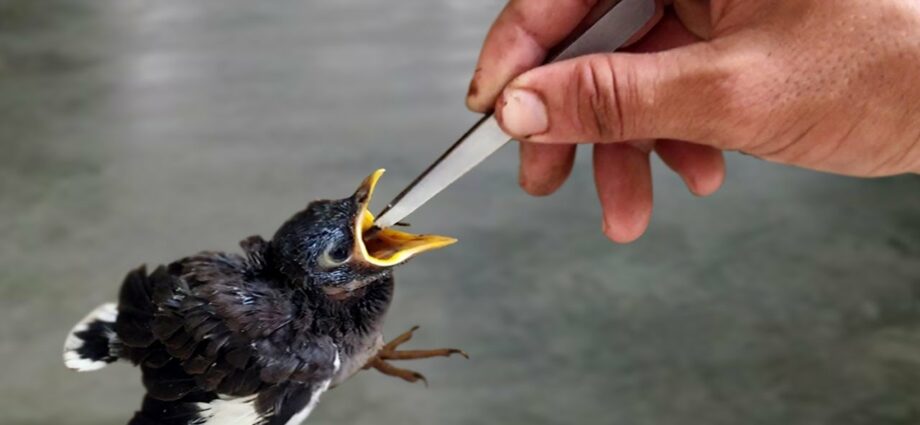Contents
How to feed a baby bird?
There are different situations in which you may need to feed a baby bird. This is the case, for example, if one of the chicks in the brood is excluded, if the parents die or if you find a young chick in distress in the wild. Here is some general information before you get started.
Be careful, however, not to take all the chicks found with you. Some find themselves on the ground naturally before they can fly, like owls for example, and therefore do not require any special help. In addition, the transport and keeping of wild animals is legally prohibited for individuals. Before removing a wild bird from its environment, it is strongly recommended to contact the League for the Protection of Birds (LPO) or the nearest wildlife care center.
What foods to choose for a baby bird?
The choice of food depends on the species of bird to be force-fed. Indeed, some birds are granivorous, that is to say they eat seeds, while others are insectivorous, for example. It is therefore necessary, as a first step, to learn about the nutritional needs of the species in question. Be careful, in some species of grain-eating birds, the growing juveniles consume insects, which are richer in protein.
For companion birds such as psittacines (parakeets, conures, parrots, etc.) or colombids (pigeons, doves, etc.), there are specific foods in the trade. It is then enough to choose a suitable food and to respect the quantities prescribed by the manufacturer. Some foods are in the form of a liquid to be reconstituted from a powder, such as infant formula. Others are in the form of mash like egg mash that should be moistened to form small balls.
Regarding wild birds, it is strongly recommended not to feed them yourself. Force-feeding and choice of feed should be restricted to trained and competent personnel. It is therefore advisable to contact the wildlife care center or the nearest LPO relay. They will tell you, depending on the species and the estimated age of the baby bird, if it requires a particular meal before it is taken care of.
Force-feeding technique
First and foremost, you should wash your hands well and clean the equipment used before handling the chick. Like all young animals, they are more fragile and susceptible to infection. Then, the force-feeding technique will depend on the species of the bird, its age and its state of health.
If the young bird is healthy, the ideal is to reproduce the natural nourishment of the parents. Thus, for example, for colombids, the young will come and get the crop milk directly from the beak of the parents. A device can therefore be created using a syringe of fairly large diameter (more than 1 mL) and self-adhesive tape. All you have to do is cut the end of the syringe and cover the cut end with strapping tape, leaving a small slit.
The fairly compact food can then be placed in the syringe which will be offered vertically, above the child, to mimic the throat of the parent.
If the baby bird is an insectivore and you need to administer small worms to it, simple forceps can be used. The tip of the instrument should not be sharp so as not to injure the oral cavity of the chick. The worm can be pinched and offered above the baby’s beak. The latter should then open the beak and wait for the worm to be deposited in it. The chitin of the worms (the hard shell) can sometimes be difficult for young birds to digest and can be removed to aid digestion.
If the chick is in poor condition or if the food offered is liquid, probing may be necessary. In this case, an atraumatic probe must be fitted to the full syringe of gavage. It can be flexible, in silicone, or rigid, in metal. Liquid food should be pushed to the end of the probe to minimize the amount of air introduced into the digestive tract. Gently handle the bird with one hand, grasping its head, just below the mandibles, between two fingers. Gently bend the neck, straight, and open the beak without forcing. Be careful, do not force the mouthpiece, which could fracture. Once the beak is open, insert the probe into the bird’s esophagus or crop, avoiding the trachea (the small hole at the base of the tongue). To do this, simply slide the probe down the back of the throat. Carefully push the gavage through the probe, making sure that there is no reflux in the oral cavity. The risk is that the food goes up and falls into the trachea. When finished, you can rinse the probe with a small amount of lukewarm water. Remove the probe without removing the syringe.
For birds with a crop, it is advisable to feel it before any feeding to avoid feeding a bird whose crop is already full. Its state of filling also dictates the rhythm of the feedings (generally every 2 hours or so).
What do I need to know?
In conclusion, feeding a baby bird is not a trivial act. The choice of food and the technique used is crucial and will depend on the species, age and health of the bird. An unsuitable food or unfortunate actions can lead, in the worst case, to the death of the animal. Thus, before starting, it is recommended to seek advice from a professional (veterinarian, trainer, breeder).










